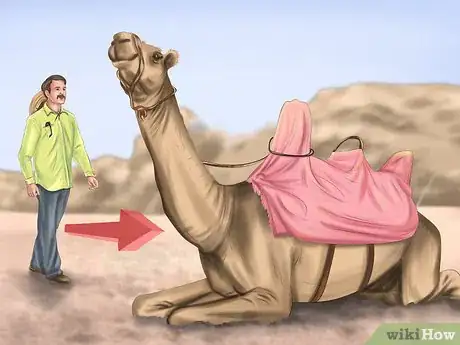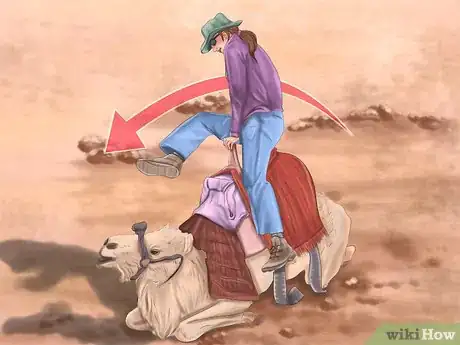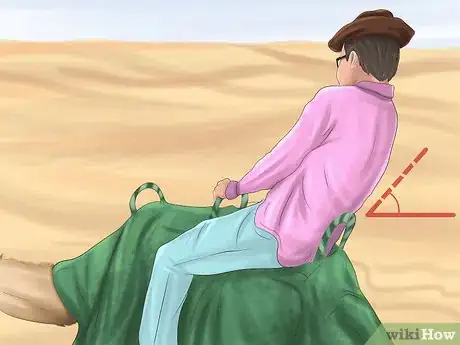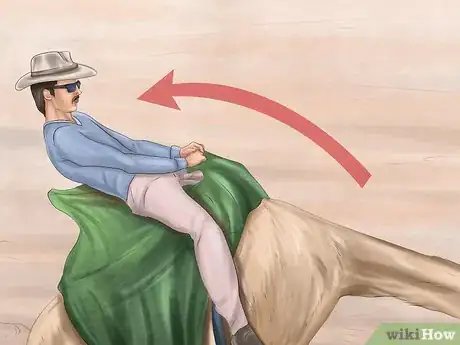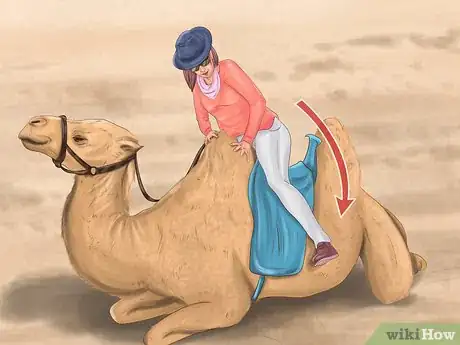wikiHow is a “wiki,” similar to Wikipedia, which means that many of our articles are co-written by multiple authors. To create this article, 22 people, some anonymous, worked to edit and improve it over time.
wikiHow marks an article as reader-approved once it receives enough positive feedback. In this case, 88% of readers who voted found the article helpful, earning it our reader-approved status.
This article has been viewed 141,399 times.
Learn more...
There is no better animal to traverse the desert than the noble camel. But getting on and riding a camel, especially if you're a novice, is anything but noble. While you will, without a doubt, be uncomfortable at first, riding a camel is not a difficult skill to pick up.
Steps
Getting on the Hump
-
1Wear long pants and long socks to protect your skin. Camels have an odd, side-to-side gait that causes a lot of friction if you aren't prepared. And the last thing you want is rough, straw-like camel hairs grinding up and down your soft legs. Your socks should come up as high as you can get them since the motion often hikes your pants up uncomfortably. Other clothing essentials include:
- A hat and sunglasses to protect your face from the sun.
- A long scarf or bandanna to protect your face in case of a dust storm.
- Dust goggles, especially if the forecast hints at possible storms.[1]
-
2Approach the sitting camel from the side, slowly and confidently. Don't look it in the eyes if you're nervous. Just stride up to it purposefully, coming from a diagonal angle. Unless you're a pro or have help, you're only going to mount the camel if the beast is sitting.
- With most guides and groups, the chance of agitating a camel is pretty low. However, there is no reason to take unnecessary risks.[2]
Advertisement -
3Throw your leg over the middle of the humps and quickly mount it. Getting on the camel is the hardest part of riding. Do it quickly, using your momentum as a guide. There is usually a stirrup on one side for your foot. Step up on this stirrup and get your other leg over and around.
- You want to be straddling the camel to keep your balance as you start riding. Once the camel stands up you can then move your legs to get more comfortable.
- There will be a handle on the front of the saddle to help you hold on as you get up.
- Some people actually mount by "leapfrogging" from behind the camel. Trust your guide's judgment if he/she suggests this — they know their animals best.
-
4Lean backward as the camel starts to stand. Camels stand up with their back legs first. If you're not careful, they'll throw you face first into their necks. Hold onto the saddle and lean back to counteract the camel's motion.
-
5Slowly lean forward as it gets onto its front legs. Once it has a sure footing with the back legs, it will move to the front. Slowly lean forward as the camel pushes up so that you end up with your back straight.
Riding Comfortably
-
1Cross one or both legs up on the saddle. While straddling the beast like a horse may seem more natural, camel riders have far more comfortable when their legs are up and crossed. This better distributes your weight along the humps, saving your tailbone from unnecessary pain. Wrap one or both legs around the saddle post to look like a pro.
- Without your legs clamped to the sides, you can sway with the camel's natural gait much more freely.
- If you're more comfortable straddling, that's fine! The leg cross is not an absolute must, although it is more comfortable on long rides.
-
2Let yourself sway with the camel. A camel's walk is odd, irregular, and herky-jerky. It is not like the measured gait of a horse, so you need to ride accordingly. Instead of fighting it, let your body swing back and forth, holding onto the saddle post for support.
- There is often another post behind your seat. Holding on to both of them, with a hand in front and a hand behind puts you in line with the camel's body and makes it easier to work with its movements.
- Tie in any valuables and electronics. This movement can easily cause things to shake loose and fall if you're not careful.
-
3Do not try and control the animal. Unfortunately, camels won't listen. Camels will listen to their master, however, and follow the line in front of them. While they may respond to the occasional tug or push, you shouldn't try to steer or direct them — they'll just be unhappy with it.
-
4Relax. This isn't just for your peace of mind. Loosening your muscles and taking a deep breath will also calm the animal down. Other camels may nip or play with your ride, but if you keep calm and cool, nothing will get out of hand. Panicking, however, may cause the creatures to panic as well. The calmer you are the calmer your ride will be.
- Once you get used to the gait, relax your grip a bit. Take a deep breath.
- Let yourself move around, but trust that you won't fall off. You'll get used to it quickly enough.
-
5Wait out any spooked or panicked camels with calm, even words. If the camel gets spooked or starts moving too quickly, stay calm. Keep a firm, but not tugging, grip on the reins and speak calmly until the camel relaxes. If you can, try to use the reins to pull the camel into a circle, so that it rides in a small area until it calms.[3]
-
6Get comfortable being uncomfortable. If you've never partnered with a camel before, know that this is not going to be the most pleasant ride of your life. You will have some pain in your tailbone, as it's not used to this sort of movement and pressure. Pop a couple of over-the-counter pain relievers thirty minutes before you go, or have some on hand to manage the pain later.[4]
-
7Dismount when the camel sits back down. Getting off is much easier than getting on. Use the saddle handles to push yourself up, then swing your leg over the hump to one side. You can simply jump off.
Community Q&A
-
QuestionHow often will I need to know this in life?
 Community AnswerThat depends on where you live and how frequently you encounter a camel.
Community AnswerThat depends on where you live and how frequently you encounter a camel. -
QuestionIt says to reward the camel. Reward the camel with what? What do they like?
 Community AnswerCamels tend to enjoy bunches of alfalfa and different fruits and vegetables such an apples or carrots. They aren't very picky and will respond well to treats and positive reinforcement.
Community AnswerCamels tend to enjoy bunches of alfalfa and different fruits and vegetables such an apples or carrots. They aren't very picky and will respond well to treats and positive reinforcement. -
QuestionWill I have arthritis pain from riding a camel if I did from riding an elephant?
 Community AnswerYes, you will likely have the same type of pain (though it is not guaranteed) because you are going to be doing a similar movement.
Community AnswerYes, you will likely have the same type of pain (though it is not guaranteed) because you are going to be doing a similar movement.
Warnings
- Be safe and follow your guide's instructions.⧼thumbs_response⧽
- Never try and agitate or approach a random camel without a guide or owner nearby. They are famously ornery animals.⧼thumbs_response⧽
References
- ↑ https://www.journeybeyondtravel.com/blog/camel-sahara-desert-morocco.html
- ↑ http://www.onthegotours.com/blog/2011/02/technical-and-practical-advice-on-how-to-ride-a-camel/
- ↑ http://www.austcamel.com.au/cache/Breaking%20in%20the%20riding%20camel.htm
- ↑ https://www.journeybeyondtravel.com/blog/camel-sahara-desert-morocco.html
About This Article
To ride a camel, start by calmly approaching it from the side while it's sitting so you don't startle it. Then, quickly throw your leg over the middle of its humps to mount it. Be careful since the camel will immediately stand after you mount it, and maintain your balance by leaning in the opposite direction it's moving in. Once the camel stands up, relax your body, and cross one or both of your legs up on the saddle so you're more comfortable. For more advice, like how to stay safe if the camel gets spooked, scroll down!

